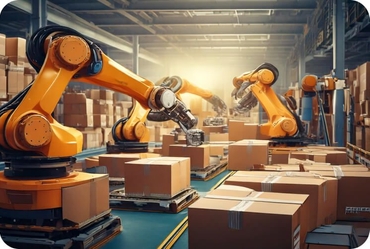
How Is Automation Transforming the Shipping Industry?
Automation is revolutionizing the shipping industry, introducing efficiency, reducing costs, and improving service quality across the supply chain. By integrating advanced technologies, shipping companies are addressing challenges like labor shortages, rising operational costs, and customer demands for faster, more reliable deliveries. Here’s how automation is reshaping the shipping industry.
1. Enhancing Port Operations
Automation has streamlined port operations by introducing technologies that minimize human intervention and improve efficiency. Key advancements include:
- Automated Cranes: Reducing loading and unloading times with precision handling.
- Smart Container Tracking: Using IoT devices to monitor container movements in real time.
- Digital Yard Management: Optimizing container placement and reducing congestion in storage areas.
These innovations enhance throughput, allowing ports to handle higher volumes with greater accuracy.
2. Optimizing Warehouse Operations
Warehouses are leveraging automation to manage inventory, fulfill orders, and reduce errors. Key applications include:
- Robotic Picking Systems: Increasing accuracy and speed in order fulfillment.
- Automated Storage and Retrieval Systems (AS/RS): Maximizing space utilization and ensuring quick access to goods.
- AI-Powered Inventory Management: Tracking stock levels in real time and predicting replenishment needs.
Automation in warehouses ensures faster order processing and reduces labor-intensive tasks.
3. Transforming Shipping Processes
Automation has introduced significant improvements to core shipping operations. Key areas of impact include:
- Self-Driving Trucks: Reducing reliance on human drivers and improving delivery efficiency.
- Drone Deliveries: Offering last-mile delivery solutions, especially in remote or urban areas.
- Automated Freight Matching: Using AI to connect shipments with the most efficient carriers.
These technologies reduce transit times and enhance delivery reliability.
4. Improving Freight Management
Freight management has become more efficient with automation tools that streamline processes and provide real-time insights. Key features include:
- Dynamic Route Optimization: Adjusting routes based on traffic and weather conditions to minimize delays.
- Freight Rate Prediction: Leveraging AI to analyze market trends and secure optimal rates.
- Automated Documentation: Reducing paperwork by generating digital invoices, customs forms, and shipping labels.
These advancements simplify logistics and improve decision-making for shipping companies.
5. Increasing Sustainability
Automation is helping the shipping industry meet sustainability goals by reducing energy consumption and waste. Examples include:
- Electric and Autonomous Vessels: Lowering emissions with cleaner fuel alternatives.
- Smart Energy Management: Monitoring and optimizing fuel usage during transit.
- Sustainable Packaging Automation: Minimizing material waste and using eco-friendly options.
Green automation initiatives align with global environmental priorities and consumer expectations.
6. Enhancing Customer Experience
Automation is improving the customer experience by providing faster and more transparent services. Features include:
- Real-Time Tracking: Offering visibility into shipment status at every stage.
- AI Chatbots: Providing instant support for customer inquiries.
- Predictive Delivery Estimates: Using data to provide accurate delivery timelines.
These improvements enhance customer trust and satisfaction, building brand loyalty.
7. Reducing Operational Costs
Automation significantly reduces operational expenses by minimizing manual labor and increasing efficiency. Cost-saving measures include:
- Labor Optimization: Reallocating human workers to more complex, value-added tasks.
- Error Reduction: Decreasing costly mistakes in order processing and documentation.
- Fuel Efficiency: Optimizing routes and vehicle performance to lower transportation costs.
These cost efficiencies allow companies to reinvest in innovation and expand their services.
8. Mitigating Supply Chain Disruptions
Automation enhances supply chain resilience by enabling faster responses to disruptions. Technologies include:
- Predictive Analytics: Identifying potential issues before they escalate.
- Real-Time Monitoring: Providing insights into shipment conditions and progress.
- Digital Twins: Simulating scenarios to plan alternative solutions in case of delays.
Proactive disruption management minimizes downtime and ensures smoother operations.
Conclusion
Automation is transforming the shipping industry by improving efficiency, reducing costs, and enhancing customer satisfaction. For more insights on automated processes and support options, check out Boxit4me’s FAQ page. From autonomous vehicles and smart port operations to AI-driven freight management, these advancements address key challenges and unlock new opportunities. As the industry continues to embrace automation, shipping companies will be better positioned to meet the demands of an increasingly interconnected and fast-paced global market.
Related Articles

What Are the Emerging Technologies for Cost-Efficient Global Shipping?

What Trends Will Shape Cross-Border Logistics in the Next Decade?
